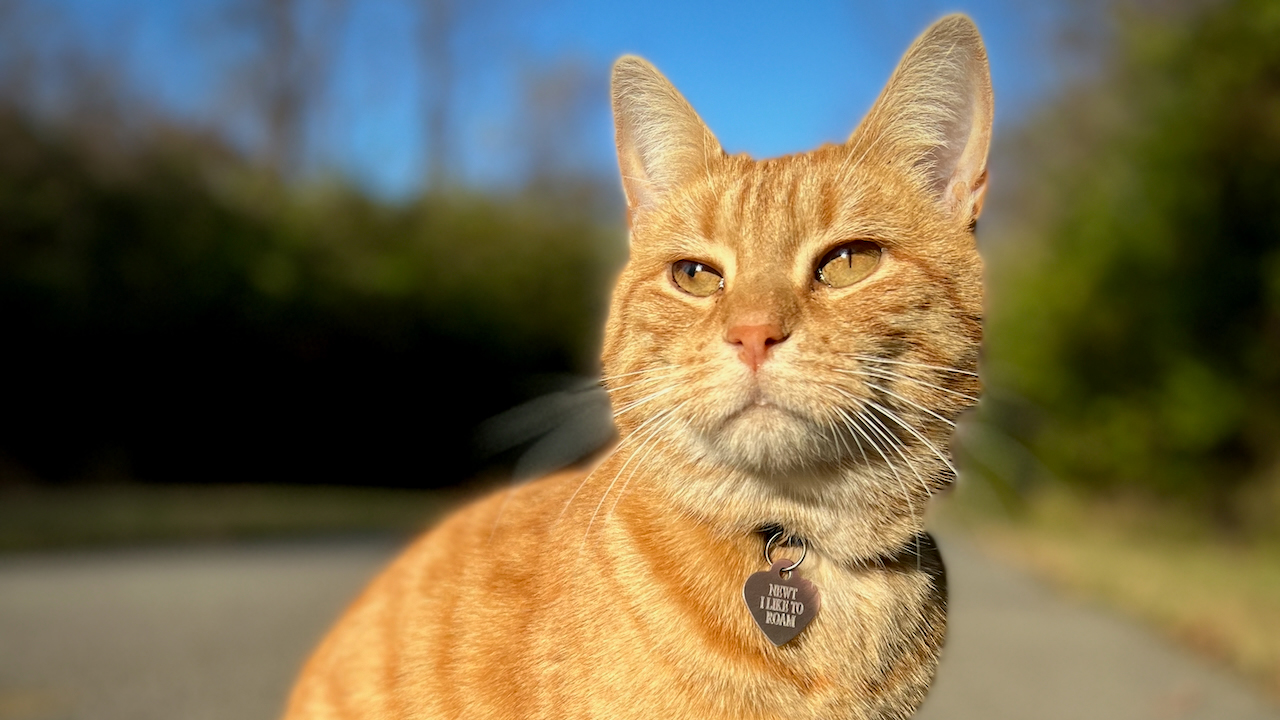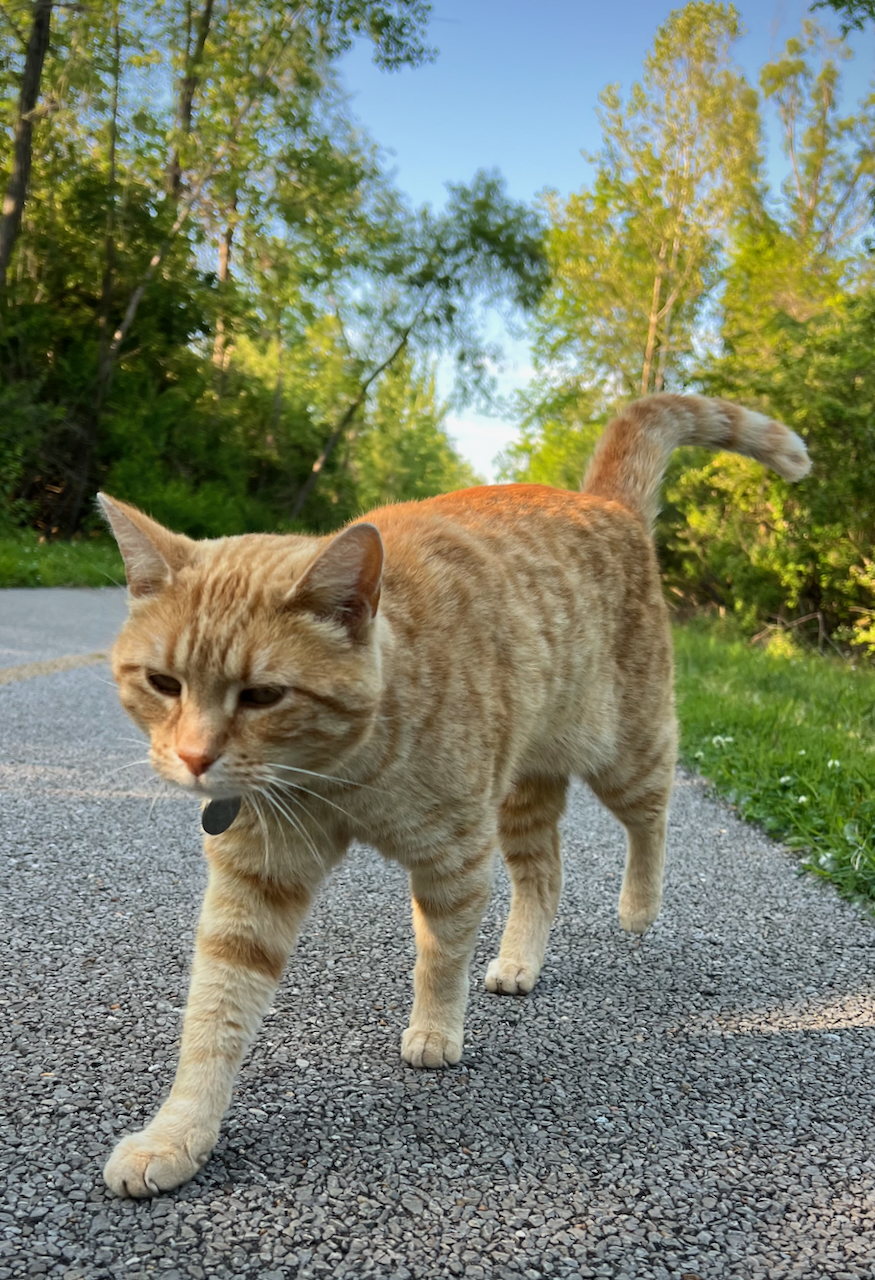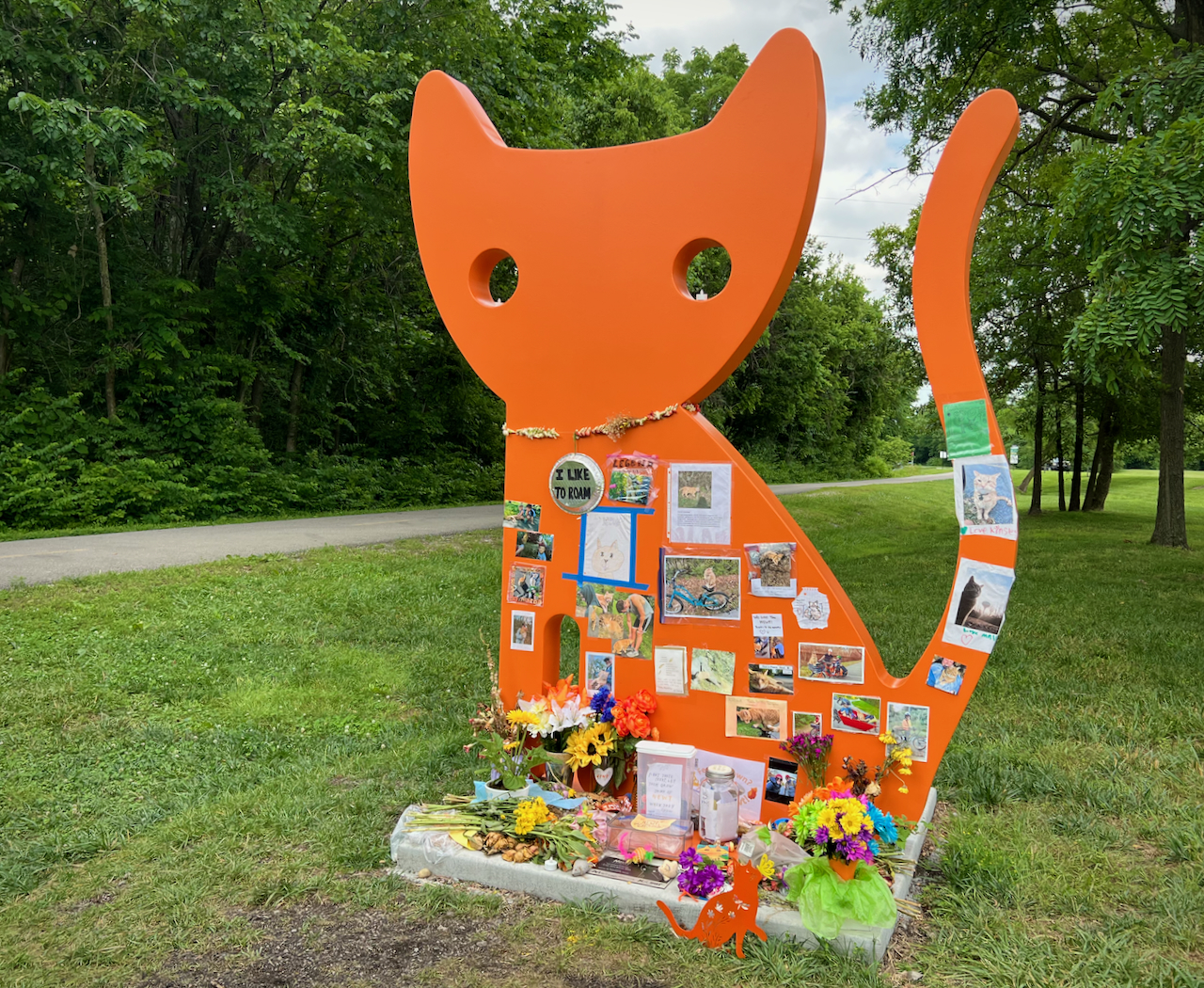
I thought you would want to know that an extraordinary being, Newt, died in May. Of the hundreds, maybe thousands, of beings I have known, he was the most peaceful, calm, affectionate, and self-directed.
Newt was a medium-sized, orange tabby cat who spent his days on a particular stretch of a paved trail system across the river from St. Louis. He often hung out near a water tower in Edwardsville, Illinois, and sometimes napped in the sun fifty yards north on a little blacktop apron or could be seen one hundred yards south by the highway underpass, where birds grip the cattails and sway in the wind. Sometimes he sat inside a gnarly bush next to the trail, like a small statue of a bodhisattva in an altar.

Bodhisattva Newt (Photo by John Griswold)
New visitors to the trail sometimes saw him lying on his side in the distance and feared the worst or saw him sitting like a loaf in the grass and thought he was a stray. Something about the way he put himself among us activated compassion, and newbies would try to feed him or return him to his owner. But his people lived in a house not far away, and he always had access to food, a bed, and medical care. They had adopted him from a local shelter, but unlike his adopted sister he wanted little to do with the indoors. His people told the local paper it would have been cruel to keep him locked up. His collar said, “Newt / I like to roam.”
I got lucky in 2019 when I chose an apartment for my son and me. My decision was based on price and the location near his new school. It turned out to be more important that it backed up to the trail, which I had barely noticed at the time. When COVID hit and the gym closed, the trail aided our physical and mental health. That was also when we met Newt. Being a newb, I thought of trying to find his owners, maybe taking him to the vet for a checkup, or making a house out of a Styrofoam cooler and hiding it in the woods for him.
His people told the local paper it would have been cruel to keep him locked up. His collar said, “Newt / I like to roam.”
Seeing Newt over time helped you to know who he was as an individual personality and fellow traveler. It was a relationship. He walked or trotted to greet visitors and sometimes sprang from the undergrowth—ta-da!—as a tiger-joke. He wrapped his tail around a shin and calf, and if he wanted up, he reached up, stretched, and tipped his claws into the flesh of a leg. If he had had enough, he walked away or sat down and looked elsewhere but did not mind if someone continued to pet him. He was always content.
It seems odd I never heard him speak, but experts say cats’ meows are mostly for humans, and he had more dignity than that. Besides, Newt did not need to curry favor; he already had trained us. On winter days his nose dripped with the cold, and I always paused my run or walk so he could warm himself on me for a few minutes. He climbed to my shoulders and lay across them like a mink stole, eyes closed, head down, and slept the way soldiers sleep because they cannot know when they will have another chance to do so. Over the years he began to get the wizened look of a tomcat, though he was just seven, and neutered. I never saw him standing on a wing, or with a mouse tail dangling from his mouth, but I am sure his stalking in the grass and bushes must have been fruitful.
• • •
I believe we earn the right to be fully present on fair days by participating in foul ones too. Newt and I were out on the trail in all seasons: biting gnat season, funny falling leaf season, frozen ear tips season, wet fur season, hot blacktop season. Many days it was just us, as most users waited for the good days. He was my constant.
There is also a beauty available only to those who pass through a landscape repeatedly over time. The Metro East trails, converted from old rail lines, do not have the immediate interest of, say, the moraines of Wisconsin. But the more time you spent on the trail, the more you saw. Lichen and rusty mushrooms became visible when the undergrowth died back in fall; white-tailed does walked alone in spring and brought their fawns around in early summer; the humid air heightened the odor of both rotting apples and last night’s skunk.
Seeing Newt over time helped you to know who he was as an individual personality and fellow traveler. It was a relationship. He walked or trotted to greet visitors and sometimes sprang from the undergrowth—ta-da!—as a tiger-joke.
Newt and I were in complete agreement about the trail’s pleasures and pitfalls. Bicycles are an annoyance and a danger to tails. The squawking of jays and crows can be a little much sometimes, do you not think? And dog owners should train their dogs better, so they do not come rushing up to poke their nose into your soft parts, expecting you to run in order to give chase.
But when cyclists stopped to fuss over him, Newt jumped up and sat on their pannier racks and seats and closed his eyes to nap. I never saw him hiss at a dog or even do the squinting, ears-back, wait-a-minute, This is going to go another way, Friendo, thing that cats do. He was cool, and dogs, unexpectedly finding themselves to be his colleagues, were left puzzled and quiet. I never saw Newt run from anything.
• • •
The ingenious part of his roaming, which he may have learned from the deer herds, was to stick close to the trails that branch for 138 miles but avoid most traffic. Still, my sons and I worried for him. I wrote about him here, one Independence Day, with the idea that total freedom might come at a price that we had to brace ourselves for.
I have never seen a stray dog in this town, but coyotes yelp at night (or any time emergency vehicles wail past), and a chat board has warned of foxes looking for house pets. Every time, from the first time, I saw Newt lying motionless on his side at a distance, I swore I would put him in my shirt and take him to a vet if that was still an option. It was never necessary; I would approach, and Newt would look up sleepily. I used to wait and watch to make sure cyclists saw him on the trail, or that that kid had good intentions. I knew these protective gestures amounted to two minutes of his long days.

The author’s last photo of Newt. (Photo by John Griswold)
Every time I saw him, I tried to take photos, but he often ruined them by running to me in a blur. Sometimes he was engaged with someone else, or I was talking on the phone and missed the shot, so I always told myself to remember in future that the last photo I had of him might not be the last time I had seen him.
I believe we earn the right to be fully present on fair days by participating in foul ones too. Newt and I were out on the trail in all seasons: biting gnat season, funny falling leaf season, frozen ear tips season, wet fur season, hot blacktop season. Many days it was just us, as most users waited for the good days. He was my constant.
One time I was walking back from the mechanic’s garage and found him on the trail, a mile away from his usual spot. I talked him into following me toward his home. He thought that was fun at first, then he lagged and finally got bored. I was a little afraid to pick him up and start marching for the water tower—who knew if he had his shots?—but I did. Love is a verb, as they say.
I guess I got a little weird from my adventures on the trail, maybe because I had suffered some personal losses and was resettling myself in the idea of transience. I brought visitors to the trail, saying something along the lines of, The theater of nature is lovely, but this is the stretch where we might see Newt. When I did see him, I told him to have a good afternoon, reminded him to go check in at home and eat something, to spend the night on a dry, soft bed. I used to call him my Zen forest spirit, my warrior cat, my tiger friend, young Zheng He, Ulysses. He was no feathercat.
• • •
He would disappear. Someone created a Newt for Mayor Facebook page, and people in the community would worry, the price for caring. I had not seen him for two weeks one time and found an orange tabby that had been hit by a car, far from Newt’s range, but it had no collar, so I knew it was not him. Newt was back in his usual haunts a couple of days later.
In November 2023 a work crew from Texas began installing a nine-foot steel sculpture of an orange cat on the part of the trail where I ran, but a bit outside Newt’s usual range. I stopped to watch them place it on its concrete pad then went home and emailed the artist. I said I thought it was great he had been commissioned by the county to make a sculpture of Newt. He said he had no idea what I was talking about and knew nothing about a real cat; his sculpture was titled “Nelson.” It was one of several different animal sculptures, which he had created in the same style, that would be installed around the county. I emailed the county administrator responsible for the contract, but he said the sculpture had no connection to Newt. The Facebook group was incredibly excited about the sculpture then upset with its name. Within days they got the piece renamed “Newt,” with a petition and the permission of Newt’s people. T-shirts were printed with Newt on them to benefit the shelter he was adopted from.
I brought visitors to the trail, saying something along the lines of, The theater of nature is lovely, but this is the stretch where we might see Newt. When I did see him, I told him to have a good afternoon, reminded him to go check in at home and eat something, to spend the night on a dry, soft bed.
Then in May of this year Newt went missing for the longest period yet. There was a community member’s report that he had been seen in the next town south; people wondered if he might have eaten poisonous mushrooms or manmade poison. At some point people began searching. I walked the trail several times, looking closely into the woods, undergrowth, a ravine. His body was found before Memorial Day. The family told the paper that “wild animals” had been at the body, but they could not tell if it was before or after death.
The outpouring of grief was intense and remarkable. Several papers wrote articles, and local TV and St. Louis Public Radio picked it up. The big sculpture became a shrine where people posted photos, messages, and other remembrances. It was hard to imagine any pedestrian creature being shown more love. Why in heaven do we not canonize animal saints that intercede on our behalf? The required miracle was his demeanor and all it brought.

“Newt,” by Texas artist Jeffie Brewer, papered with tributes. (Photo by John Griswold)
After a couple of weeks, the county took everything at the sculpture site and gave it to Newt’s people. The Facebook page was renamed to serve cyclists using the trails, but people still mention Newt. Last week a park bench dedicated to him appeared on the trail near the water tower. It has a a life-sized cat statue mounted under it, curled as if in sleep. A young man in a town south of here used his 3D printer to make plastic miniatures and keychains of the nine-foot sculpture, with the artist’s blessing, to benefit charity.
None of us, including Newt’s owners, really knew how much he got around until he got us all talking about him. People said they had seen him in the night by headlight; he roamed far wider than we thought. One crazy woman had taken him on a five-mile bike ride; Newt was equanimous as always, it seems. The comic surprise that lined the grief was that hundreds of us thought of him as our own.
“Everyone’s boy!!!!!” someone posted, with a broken-heart gif.
But no one belongs to anyone, as much as we might wish it was so. Those we love disappear. For a couple of months the trail lost its texture and interest for me. Still, it is nice to have a statue.
• • •
The problem of wisdom is not what we can know. It is what can be done with the knowledge we bear.
I was thinking of the film Grand Budapest Hotel, in which an old man (F. Murray Abraham) tells the story of his early life to a young writer (Jude Law). The great influence on the man’s life was his employer: a surrogate father, friend, and partner in crime, a man who gave him a vocation, an education, and a home, and saved him from fascists.
After hearing of their adventures, the writer asks what happened to the employer in the end.
“In the end, they shot him,” the old man says calmly. “So it all went to me.”
“It” was the employer’s fortune but also, more importantly, memories and feeling. The old man traded his inherited fortune to the new communist government for this one decrepit hotel, where he was happy for a time, he says, with his wife and child, both of whom died quickly of wartime influenza.
The old man ascends alone in the elevator to his room, barely bigger than his bed. The young writer sits in the hotel lobby and begins to write, as mountain yodelers sing something that sounds like “yolo.” We see the young writer turn old, then he becomes a bust in a graveyard and an author’s photo in a book beloved by a young reader.
In the end, remembrance is a burden as well as a gift. It saves imperfectly. It reminds that the only salvation is in the work of all weather—making connections with fellow beings on the same path.
